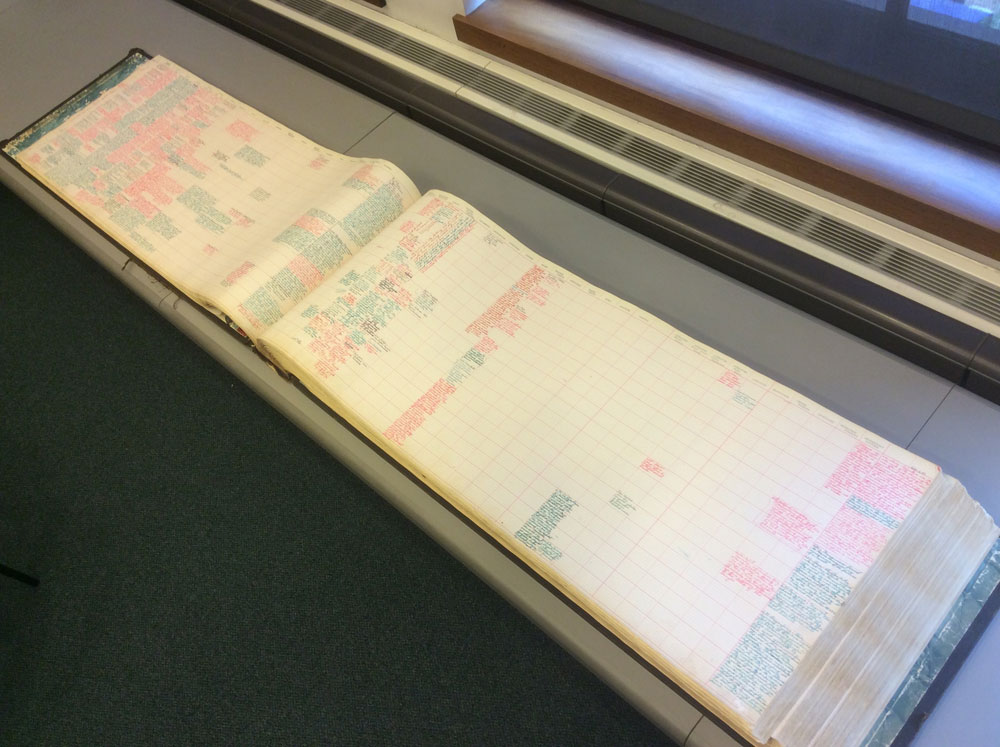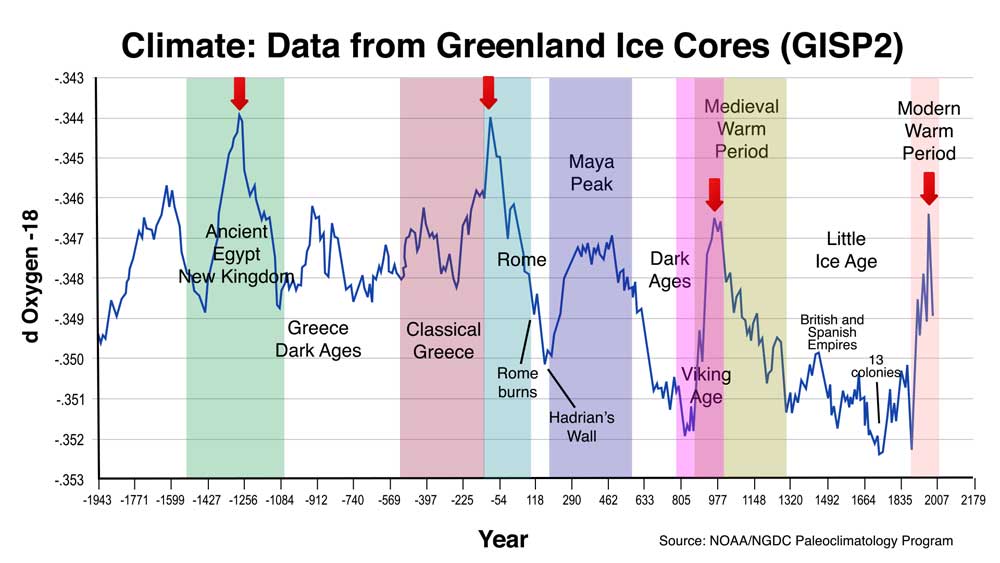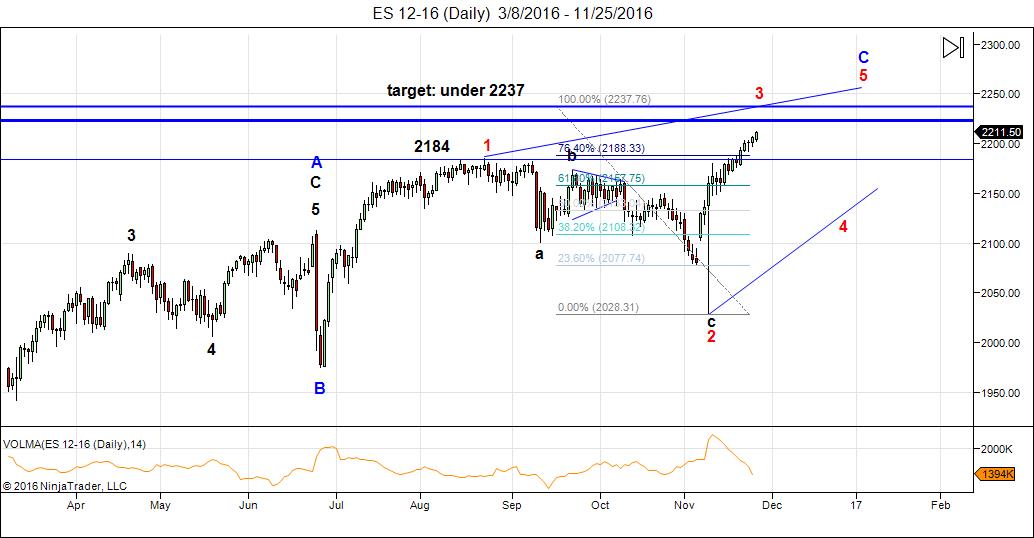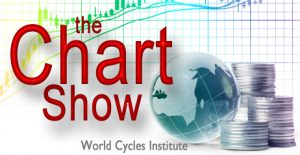I’ve been preparing for another trip to New York City a couple of weeks from now to do more research into the work of Dr. Raymond Wheeler and The Big Book.

The Big Book (above) is a tome of about 2,000 pages that Dr. Wheeler created over a ten year period in which he’s recorded all the major events from 600 BC until about 1940. Along with the events, he’s also recorded the temperature and level of precipitation. He’s come to very strong conclusions about the cycles of our past and how they’ll affect our future. His work on climate has been backed up by the GISP2 data derived from Greenland ice cores much more recently (199os), so the science is solid.
The luminaries that I follow include Ralph Nelson Elliott (of course), Ellsworth Huntington, Edward Dewey, Alexander Chizhevsky, Nikolai Kondratiev, and Dr. Wheeler, amongst others. Working independently in the early 20th century, they all came to the same conclusions: Everything on Earth is influenced by cycles, created by exogenous forces.
I thought that this weekend, I’d share a bit of Dr. Wheeler’s writings, which first appeared in the Journal of Human Ecology, in 1951.
_____________________________
“Every second 500-year period in history belongs to Western Civilization. Every intervening 500-year period belongs to Eastern Civilization. Europe and North America have dominated a 500-year period just now ending. The next 500 years of history will belong to Asia.
At the end of each 500-year cycle, but more especially at the end of every other 500-year cycle, major revolutions occur over the whole world that result in drastic reorganizations of society. One feature of these revolutions is a sudden spurt in the growth of democratic institutions. We are in a revolution of this sort now, comparable to the collapse of medieval culture and the beginning of the modem world. A great Renaissance is due at the end of the century with the masses of the people participating in the economic and political structure to an extent unknown before in history. Neither Fascism nor Communism, but Democracy, will prevail as a consequence of the revolution.
This is a brief account of world history in relation to long climatic cycles, or cycles in the long-time weather trends. The main division points of history are also landmarks in the history of world climate. Old civilizations collapse and new civilizations are born on tides of climatic change. The turning points occur when cold-dry times reach their maximum severity. This happens about every 500 years.
The main divisions of history as recorded by the historians—Ancient, Medieval, and Modern—are not just divisions in history. They are also divisions in the long-time weather trends. The last great epoch of the ancient world began in the sixth century B.C. with the decline or Egypt and the older empires of the Middle East on the one hand, and the emergence of Grecian civilization and Persia on the other. This new epoch of the ancient world came to an end in fifth century A.D., a thousand years later. (Above is a chart I developed from data from the GISP2 ice core project delivered in the early 1990s).
(Above is a chart I developed from data from the GISP2 ice core project delivered in the early 1990s).
Then came the Middle Ages. This period, too, lasted a thousand years, and came to an end in the 15th century, when the modern world began, ushered in by the Renaissance and the Reformation. A thousand years would bring us to the 25th century A.D., 500 years from now.
Various lines of evidence, to be published elsewhere, show how the sixth century B.C. and the fifth century A.D. centered on unusually cold and dry times. Both were centuries of widespread migrations; both were periods of low lake levels and slow tree growth. The 15th century also centered in unusually cold and dry times. All three, the sixth B.C., the fifth, and 15th centuries A.D. witnessed profound social upheavals throughout the whole world of humanity. All three were characterized by the same process—the dying of all old world and the birth of a new one.
In the center of each 1,000 year cycle there seems to have been a much warmer period in history, the first reaching a climax at the time of Julius and Augustus Caesar, the second around 900 and 1000 A.D. During the second of these warmer periods, Greenland and Iceland were colonized.
Once the warm phase had run its course, the cold phase of the long cycle was on its way. Greenland froze up and has remained so ever since. Many times in the 14th and 15th centuries the Baltic Sea froze over between Germany and Sweden, allowing people and horses to cross from one country to the other on the ice. It is evident at the present time that the earth has been getting much warmer again. The frozen northlands have been receding, along with glaciers, over the world. Animals frozen in their tracks by just such a blizzard as struck the mountain states two years ago, but when so much snow fell that it never thereafter melted until now, have in recent decades been exposed, sometimes with their flesh still edible. It is not difficult to understand why this is happening as the world is approaching again the heat climax of a 1000-year cycle. In fact, if this is true there is reason for believing that around 2040, perhaps a little earlier, perhaps a little later, a heat climax will occur that will exceed our recent one of the 1930s. This might well be the climax of the current 1000-year cycle. After that, glaciers will start advancing again and the world’s temperatures will fall, gradually, until a cold climax is reached around 2500 A.D. Then the modern world will again experience an upheaval as complete as that which terminated the Middle Ages and inaugurated the Modern World.
However, both climatically and culturally, secondary climaxes of cold temperatures and devastating droughts, with great waves of migrations and immigrations, accompanied by drastic revolutions in society, have occurred at the end of each intervening 500-year period. In other words, there is a 500-year climate and culture cycle as well as a 1000·year cycle. Every other termination of the 500-year cycle has coincided with the termination of the 1000-year one, but every alternate 500-year cycle has terminated in the middle of the 1,000-year rhythm during its warm phase. However, there has always been a complication. The 500-year cycle breaks down into shorter periods that last, on the average, about 100·years in length. These are clear-cut cycles each having a major warm phase and a major cold phase, two major wet periods, and two major dry periods. One major wet period occurs at the beginning of the warm phase, the other at the beginning of the cold phase. One major dry period occurs at the end of the warm phase, and one occurs at the end of the cold phase.
Each fifth cold phase is an unusually severe one as was true in the fifth century B.C., the first century A.D., the fifth century, the tenth century, and the 15th century. All the signs point to a continued repetition of the rhythm. The rest of this century is due to average severely cold. We are at the present moment beginning the cold phase of the 100·year cycle and the fifth and severest cold phase of the 500-year cycle. This will temporarily check (it is starting to do so now) the rising of world temperatures on the 1000-year cycle, popularized so much in recent literature.
We said that the 500-year period was a cultural as well as a climatic cycle. Half of the terminations of this cycle have already been accounted for by the 1000-year cycle.
What of the other terminations? The first 500-year cycle of history terminated at the time Christ was born. Until 70 A.D. much of the first century was cold. Rome had just passed her cultural prime. The great empire that had taken 500 years to build now sank lower and lower for the next 500 years until it collapsed altogether. The scene of initiative in the world shifted from the West to the East. A Dark Age ensued in most of the West. Turkish peoples, Tartars, and Huns built one large empire after another in Asia. In the West, Christianity inspired one of the most profound cultural revolutions in all history. And so it was that both in the East and in the West a new world replaced the old one. This new world came to an end in the fifth century.
The first half of the medieval period, the fifth to the tenth centuries, belonged to Europe. Asia declined in political but not in cultural initiative. In the West came Justinian and the great Byzantine Empire, together with an upsurge of Arabian civilization, which soon marched across North Africa into Spain. At the time this outburst of energy was occurring, China and Japan went through an important cultural renaissance. Then came Charlemagne In the West and the Golden Age of Bagdad in the East. This finished the first half of the Middle Ages. The close of the 500-year cycle saw all of these civilizations fall into decline, to be replaced in Europe by the feudal principality, which was the beginning of the modern state with its economic and cultural development based on nationalism. It was during this dying of an old world and the birth of a new one that the European countries—England, Scotland, Denmark, Norway, Sweden, Russia, France, Germany—were born. This was indeed a great revolution in society political, economic, and cultural. It occurred as one 500-year cycle finished in a severely cold period, and another began. However, the greatest initiative during the 500 year period from the tenth to the 15th centuries, was again taken by Asia. Witness the unparalleled empires of the Khans and the emergence of the Seljuk Turks, then in the late 14th century, Tamerlane.
Great storms, followed by bitter cold, devastated Asia in the ninth and tenth centuries, and also drove hordes of Normans out of the northern Scandinavian countries until they had overrun Europe, even to southern Italy, and had conquered England. This was at the termination of the 500-year cycle.
Then, 500 years later, came the fall of the Middle Ages which involved one of the must drastic revolutions perhaps ever to have gripped the races of the earth. This was especially true of Europe, for it was the beginning of the 500-year cycle that belonged to Europe. Once more, Asia quieted down.”
________________________
Ending Diagonals
We continue to work our way through the ending diagonal.
Ending diagonals suggest a market that is extremely weak and barely able to trace out a new high. Although it falls under the banner of a motive wave, it has properties more aligned with corrective waves. Ralph Elliott described an ending diagonal as occupying the fifth wave position of a motive wave when the preceding move has gone “too far too fast.” He maintained that it indicates “exhaustion of the larger movement.”
Projection for a Top
Based on the ending diagonal we’re currently in (which is the pattern playing out in all the major US indices), I’m projecting a final top to our five hundred year set of Supercycle waves at the end of the 2016 year or into early January. I’m leaning towards the end of December or early January.
______________________________
Here’s the latest daily chart of ES (emini futures):
The “top end” for the 3rd wave is 2237 (where wave 1=3). The third wave cannot be longer than the first wave (a hard rule in Elliottwave). I’m expecting a more likely turn at about 2222-4.
Wave 3 also has to reach a new high. We’ve now achieved that. The previous wave 1 high is 2184, and it’s been exceeded. You should begin to look for a top to wave 3.
This will be followed by a smaller wave 4 down and then wave 5 to a final top.
Summary: We are completing the third wave of the ending diagonal before zigzagging to the top of the largest bubble in history. The long awaited bear market is getting closer.
___________________________
Sign up for: The Chart Show
Thursday, December 1 at 2:00 pm EST (US market time)
 The Chart Show is a one hour webinar in which Peter Temple provides the Elliott Wave analysis in real time for the US market, gold, silver, oil, and major USD currency pairs.
The Chart Show is a one hour webinar in which Peter Temple provides the Elliott Wave analysis in real time for the US market, gold, silver, oil, and major USD currency pairs.
Get caught up on the market from an Elliott Wave perspective. You’ll also get Andy Pancholi turn dates for the balance of the current month. There’ll be a Q&A session during and at the end of the webinar and the possibility (depending on time) of taking requests.
All registrants will receive the video playback of the webinar, so even if you miss it, you’ll be sent the full video replay within about an hour of its conclusion. For more information and to sign up, click here.



Peter
your opening my eyes to global cooling with your research
of Dr wheeler , as a person who is also interested in global
cooling
I thank you 🙂
Joe
Joe,
You’re welcome, as always.
Joe, your last comment in the previous post resonated with me HUGELY….or is that UUUGELY? I need to be sure of my vocabulary here. Lol. In any case there were some very clear calculations that made me sit up and ‘think’. Something that I haven’t done for a VERY LOONG TIME.
Peter, I have come to ‘RELISH’ your weekly posts far more than when they pertained to markets only. Your wider research and ability to distill that into easily readable chunks is what I look forward to.
Many MANY THANKS.
purvez
Purvez,
Thanks, eh!
🙂
Vocabulary Peter, vocabulary!! eh!! LOL.
To a Canadian, that’s the core of our language!
‘Nuff said.
Adjective, adverb, article (and we’re working on the noun and verb…)
HEHEHEHEH!!
ALL THIS KNOWLEDGE ……. and then HUMOUR TOO. You are ONE OF A KIND. Thanks
Yeah, sorry about that (more proof I’m Canadian – we apologize for everything, sorry).
I was actually born in London, so you have something else to be worried about … lol.
Good stuff Peet, good stuff! 🙂
Cheers my friend,
W
Hi Peter,
Have you heard of “The Electric Universe”? If you watch “Symbols of an Alien Sky” on youtube which is a one hour presentation of the concept, believe it may be of interest. This cosmology may be relevant to your cycles work. There are Electric Universe conferences twice a year where scientists and scholars discuss recent findings. In a nut shell, the theory is that current planetary positions are not very ancient which may mean that the future of weather patterns may vary from those of last few millennia.
Valley,
No, I hadn’t heard of it. However, I’ve found a couple of websites in the last couple of minutes, so I’ll wander around perhaps on the weekend and see what I can find. I don’t yet see info on a conference for 2017, but I’ll keep looking …
Thanks!
Hi Peter,
I find their videos on youtube to be the best and quickest way to dial into the theory and the cosmology that they discuss. Wal Thornhill (Australian) and David Talbott (USA) are the founders and there are many youtube videos of them and of the Electric Universe previous conferences. Their work is an elaborate and eloquent extension of the work of Emanual Velokofsky.
Thanks, Valley,
Just bought Worlds in Collision.
Valley,
Cool. I just looked at their main video. This all makes sense. I’ve always thought of exogenous forces as electromagnetic. The books of Dr. Robert Becker regarding the human body and regeneration suggest that the base of everything is electrical.
I will spend some more time with Electric Universe. Thanks for pointing this out to me. 🙂
It was transformative when I assimilated their thesis a few years ago. I watched “Symbols of Alien Sky” narrated by David Talbott on youtube many times until I could quote some of it from memory. “Saturn was the best sun” “Helios was greek for planet Saturn” And according to their research, name for sun in all ancient civilizations referred to Saturn not the current sun. This era (probably 5000 years and before) was known as the “purple dawn of creation” because of the low luminosity of a brown dwarf star such as Saturn.
This is the final paragraph from a very long and quite difficult to read/understand piece by J Snider of Alhambra partners.
“Picture a river or large pool of water on the African plain at the end of the rainy season. As the availability of water overall shrinks, it causes increasing conflicts among the many individual animals as well as between species. The growing intensity of conflict and struggle from those animals and those groups of animals has the effect of depriving still others their place at the water’s edge where they might otherwise get at least a small drink to survive another day.”
His writing is sadly dense but his work is impeccable and if he is anywhere near the mark on what he is saying then I think we are going to see some REAL TROUBLE over the next month or 2.
BTW he’s describing money markets above not the Serengeti plains.
Here’s the link:
http://www.alhambrapartners.com/2016/11/22/repo-on-the-african-plain/
To me, the scarier analogy is living in a big city and I’d extend the timeframe to the next five years or so. I don’t like mother nature’s idea of playing with human nature by introducing scarcity into the societal equation.
Peter,
I apologize if, out of forgetfulness, I have mentioned this reference before to you, but have you reviewed a book by Brad Steiger, ‘A Roadmap of Time – How the Maxwell/Wheeler weather Energy Cycles Predict the History of the next 25 years’? I can’t remember much of it other than the observation in an elevator – it’s not where you end up that’s important… Anyway, I’m cleaning out my study and rediscovered the book. Thought I would pass it on in case you have not read it (sounds like you are a book hound!
Steve,
Ooooo… that sounds like a “find!” I didn’t know about it. I’m a Wheeler hound first and cycles book hound second. Thanks! I’ll go looking for it.
I have it on order. It was hard to find someone to ship to Canada … which is odd.
Peter,
So are we in wave 4 going down now?
Roger,
I’m going to assume you’re referring to ES. If that’s the case, I would think not.
Peter-
So potentially we are in B of 3?
Ted,
I put us still in the C wave of wave 3 of the ending diagonal.
If we turn down before getting to a new high now in ES, we will be heading into a larger fourth.
Got a trading plan either way :). Stay nimble! Thanks Peter!
Just testing to see if this post appears! Hard to believe that no one is posting anything!
Sorry, Ed,
we are all concentrated on our trades
Ed, Dimitri is right. We are at that ‘wile e coyote’ moment when he’s run off the cliff but not realised that there is nothing further underneath. I’m waiting patiently (with a bunch of other people) for the market to look ‘down’ and realise that there is no ‘solid ground’ left underneath.
http://www.zerohedge.com/news/2016-12-02/do-1901-expedition-logbooks-confirm-there-no-global-warming
PALS and US stocks next week:
Phase: negative all week
Distance: very positive all week
Declination: positive all week
Seasonals: December is usually positive until mid month
Summary: 3 of 4 indicators are positive so I am bullish next week.
A new post is live: https://worldcyclesinstitute.com/the-41-month-stock-market-cycle/
This website is for educational purposes relating to Elliott Wave, natural cycles, and the Quantum Revolution (Great Awakening). I welcome questions or comments about any of these subjects. Due to a heavy schedule, I may not have the time to answer questions that relate to my area of expertise.
I reserve the right to remove any comment that is deemed negative, is unhelpful, or off-topic. Such comments may be removed.
Want to comment? You need to be logged in to comment. You can register here.